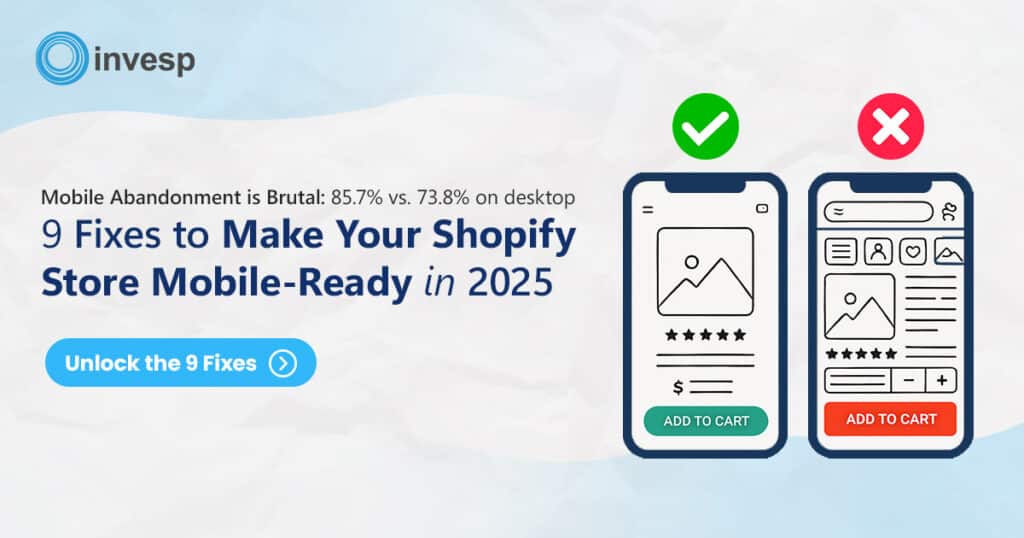Disclaimer: This section is a TL;DR of the main article and it’s for you if you’re not interested in reading the whole article. On the other hand, if you want to read the full blog, just scroll down and you’ll see the introduction.
- The value that Conversion Rate Optimization (CRO) brings to the table is now indisputable. Although we still see top executives who are skeptical of its value, the CRO concept has proved its worth to the mainstream.
- There are different components that make up a good CRO program, and they’re listed below.
- CRO Tools: As with every trade, conversion optimizers require tools to perform their optimization work. Understanding how to use the tools is more important, as it might also determine your CRO program’s success. When it comes to CRO tools, where do you start, and how do you smartly use them? The best way of going about it is to segregate the tools into three categories: Web Analytics, User Behavior tools, and AB testing platforms.
- The team makeup: It goes without saying that a dedicated CRO team is a crucial lever for a successful CRO program. This means that the way you build and structure your team is as important as the CRO program itself. There are 3 team structures to choose from; the centralized structure, the decentralized structure, and the hybrid structure.
- The CRO budget: An effective CRO program requires an investment of money. The good news is that conversion optimization is all about dollars and cents — this means that you’re bound to see its positive impact on your bottom line if experts execute the program. Under CRO budget, it’s important to look at human capital, duration of the project, cost of A/B testing tools, etc.
- The methodology: How you do conversion optimization matters. A successful CRO program requires a well-defined process. This is key. Without a well-defined process, a CRO program can lack direction. Having a CRO methodology to follow, you’d know which issues to focus on first and which ones you should ignore. In other words, following a CRO process will serve you time and resources.
- Setting the right expectations: Setting the right and transparent expectations before diving into the CRO project is imperative. As a service-based company that offers website conversion optimization services, we have learned over the years that expectations are either the road to bliss or damnation.
- Good project management: Project management is that piece of the puzzle many CEOs relegate to the backseat of a conversion program. But its importance in a CRO program can’t be overstated. Better CRO project management = better CRO programs. When project management is done right, it helps the CRO program run more smoothly.
Here’s A Longer And More Detailed Version Of The Article.
The value that Conversion Rate Optimization (CRO) brings to the table is now indisputable. Although we still come across top executives who are skeptical of its value, the CRO concept has proved its worth to the mainstream.
However, most organizations’ implementation of a CRO program is still not optimal, which could be why some managers are still skeptical.
While the outcomes associated with a successful CRO program are obvious, ranging from improved conversions to high retention rates, the suboptimal optimization program’s consequences are frequently overlooked. And they can hurt your business where it matters the most – ROI.
So, when can you be sure that you can execute a successful CRO program?
Well, pay attention to the following components, and you will get there:
Step 1: Choose the Right CRO Tools
In the 1910s, Henry Ford introduced the assembly line, revolutionizing the automotive industry. Production got faster. Results became trackable. Mistakes could be spotted and fixed quickly.
Choosing the right CRO tools is your website’s version of that assembly line. CRO tools give you a repeatable process to:
- Understand why visitors aren’t converting into leads or customers
- Identify possible changes to make to your website to increase conversions
- Test changes you make to your site for the highest conversion rates
Just like Ford’s assembly line had dedicated stations for inspection, repair, and quality control, your CRO “line” needs the right combination of tools working together. These CRO tools fall into three interlocking categories:
- Analytics tools: They track what is happening (pageviews, bounce rates, funnel drop‑offs). Examples: Google Analytics (GA4), Mixpanel, Adobe Analytics, Plausible.
- Customer behavioral research tools: They show why users behave the way they do. This includes heatmaps, session replays, on‑page surveys, and usability tests. Examples: FigPii, VWO Insights, Hotjar, UserTesting.com.
- Experimentation tools: These tools let you validate changes with real users (A/B, multivariate, split‑URL tests). Examples: FigPii, VWO testing, AB Tasty.
Analytics Platforms: Tracking What’s Happening
Without web analytics, you wouldn’t know what’s happening on your site. And without that, you can’t make informed improvements.
Analytics tools like GA4 provide quantitative data about your website and its visitors: sessions, bounce rates, drop-offs, engagement rates, and more. They answer questions like:
-
Which pages are leaking the most traffic?
-
Where do people bounce, abandon, or stall?
-
Which campaigns actually drive high-value users?
-
Which devices or browsers are visitors using?
-
How many visitors are leaving without converting?
Here’s what GA4 data actually looks like, showing things like engagement rate, bounce rate, and conversions for each traffic source.
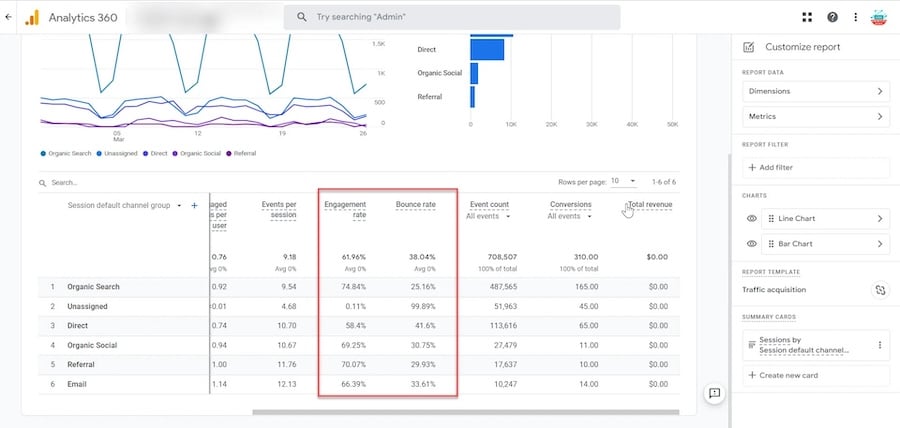
A GA4 report showing engagement rate, bounce rate, and conversions broken down by traffic source (Source)
Analytics tools measure performance, giving you a clear picture of site health before you prescribe a solution.
Most companies usually start with Google Analytics (GA4). It’s installed on more than 56% of all websites globally, making it the default analytics layer for marketers everywhere.
But simply installing GA isn’t enough to drive conversions.
- GA4 doesn’t automatically map out your entire customer journey. You’ll see which pages people visit, but not why they left.
- Without Enhanced Ecommerce—GA’s advanced setting for tracking product impressions, add‑to‑cart rates, and checkout steps—you’ll miss the story behind how buyers actually move (or don’t) through your store.
- If you’re not configuring events and goals, you’re blind to micro‑conversions—the small steps that signal intent, like clicking a product video or checking a size chart.
As Khalid Saleh, CRO expert, co‑author of the bestselling book about Conversion Optimization and co-founder of Invesp, puts it:
“Most companies we work with already have Google Analytics installed on their site. The challenge is that GA out of the box does not give you all the information you need to improve conversions. It merely reports page metrics. When you are to increase conversions, you have to look at the whole customer journey on your site. Because of that, you have to do further set up in Google analytics. If you are an ecommerce site, having enhanced ecommerce and making sure that it is configured correctly is a must. In addition, you have to configure two things: 1. events for different actions on the site, and 2. Different goals and funnels to track how visitors navigate around the site.“
You can delve deeper into how to utilize Google Analytics to enhance conversions here.
And while GA4 is the go‑to for most companies, it’s not the only option. On many CRO projects, we also use tools like Adobe Analytics and Heap, each offering its own strengths for tracking user behavior.
Not sure those are the right fit for you? We’ve compiled a comprehensive list of analytics platforms worth exploring. Check out the full list for the best website analytics tools here.
Customer Behavioral Research Tools: Seeing Why Visitors Act the Way They Do
If analytics tools tell you “what’s happening?,” behavior research tools tell “why is it happening?”
Analytics might show that 42% of users left your pricing page or that the mobile bounce rate is 61%. But numbers alone can’t reveal the cause. As the book Making Websites Win puts it:
“Numbers tell you what’s wrong. Stories tell you why it’s wrong. You need both if you want to change the outcome.”
Behavior tools provide the stories. They let you step into your visitors’ shoes and see your website the way they do, helping you identify even the smallest moments of confusion or frustration that lead to a drop-off.
For example, after analytics tools flag a high exit rate on your pricing page, a behavior tool might reveal visitors hovering over the “Enterprise Plan” for 30 seconds before leaving, or scrolling past your CTA because it’s buried too far down.
Behavioral research tools answer questions that analytic tools can’t:
- Where do users rage-click or hesitate?
- Which form fields frustrate them?
- Are they scrolling far enough to see my CTA?
- What are they saying—literally—in on-page feedback?
Instead of another spreadsheet, you’re looking at:
- Heatmaps showing where users click, scroll, and hover.
- Session recordings revealing the exact moment they get stuck.
- On-page surveys and polls capture their thoughts as they browse.
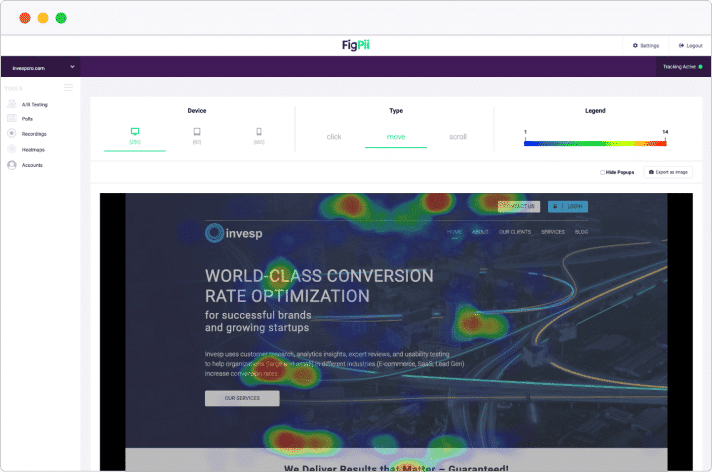
FigPii’s heatmap reveals “hot zones” where users are actively engaging (red and yellow) and “cold zones” they’re ignoring (blue), helping you understand where attention flows on a page (Source)
At Invesp, we use our proprietary CRO tool FigPii for this type of customer behavior analysis. It combines heatmaps, session replays, surveys, and A/B testing in one dashboard, so you can spot an issue and test a fix without switching tools.
But knowing these tools exist isn’t enough, you have to use them with intention. Here’s how to get the most out of them:
- Start with heatmaps. Run them on high-traffic pages like your homepage, top product pages, and checkout.
- Watch session recordings with a focus. Don’t binge-watch like Netflix—filter by sessions where users dropped off or completed key actions.
- Deploy micro-surveys. Ask visitors one simple question at the right moment—for example, “What’s stopping you from checking out today?”—to get gold-standard insight.
- Close the loop. Feed those observations into your analytics data and hypothesis list for testing.
CRO Testing Tools: Compare and Measure Changes on Your Website
If analytics tells you what is happening and behavior tools tell you why, experimentation tools let you change the outcome.
Once you’ve identified friction points (think, a clunky checkout, an ignored CTA), experimentation tools let you test different solutions and see what truly works.
Experimentation tools allow you to:
- Run A/B tests (two versions of a page against each other) to see which converts better.
- Run multivariate tests (testing several elements at once, like headlines, CTAs, and images).
- Create split URL tests to compare entirely different pages.
- Deploy server-side tests (for features and functionality) or client-side ones (for design and messaging).
In short, these platforms give you a scientific framework for answering questions like:
Does a one-step checkout convert better than two steps?
Would adding a product video improve add‑to‑cart rates?
Is our new pricing page messaging helping or hurting signups?
Let’s see how it works in action:
When working with a DTC brand, we tested two variations of a “Free Shipping” incentive on the cart page.
We tested two different versions of the cart page, each displaying the message “Add $27 to unlock FREE SHIPPING,” and compared them against the original version, which had no incentive message at all.
- V1: Incentive message placed above the product list in the cart.
- V2: Incentive message placed below the product list.

The goal was simple: reduce checkout drop-offs and encourage larger orders.
The results were mixed, and that’s precisely why testing matters.
- Checkout and purchase rates declined slightly in both V1 and V2, which means that the incentive positioning may have distracted or overloaded users.
- However, upsell clicks increased by up to 80%, suggesting the visual hierarchy of the incentive changed browsing behavior even if it didn’t ultimately close more sales.

A/B test results comparing two incentive message placements with a no-incentive control. While Variation 2 slightly increased revenue per visitor, both variants underperformed in conversion rate compared to the original layout.
But these insights still helped.
They gave us clarity on what not to pursue and opened up new hypotheses to test next.
That’s the real value of experimentation tools: they don’t just validate ideas, they guide your entire decision-making process.
One important caveat: even the best experimentation tools can only deliver reliable results if you have enough data to work with. As Khalid points out:
“When you’re only getting 100, 200, or 300 visitors per week, it’s difficult for conversion optimizers to really figure out intent… drive at least 10,000 or 20,000 visitors in order to figure conversion problems on your site.”
If your traffic is too low for statistically significant A/B tests, you can still improve conversions using other methods, such as:
-
User/usability testing – Small groups interacting with your site to validate changes
-
Tree testing and card sorting – Improving navigation and content structure
-
Session replay analysis – Spotting clear usability issues without running tests
The good news is, you don’t need a massive tech stack to do this. Here are some CRO tools that can help you run these alternative testing methods:
-
FigPii – A/B testing plus heatmaps, session replays, and surveys
-
User testing – User/usability testing
-
Optimal Workshop – Tree testing and card sorting
-
VWO – A/B testing and multivariate testing
How All Three CRO Tools Work Together:
You’ve now seen how analytics, behavior research, and experimentation each play their part. But the real power of CRO comes when you connect them into one continuous process.
When combined, these tools create a closed-loop optimization system:
-
Analytics spots where the problem is.
-
Behavior tools explain why it’s happening.
-
Experimentation tools validate the best fix.
This cycle repeats, refining your site with every pass, and turns optimization from a one-off project into an ongoing growth engine.
2. The team make up
It goes without saying that a dedicated CRO team is a crucial lever for a successful CRO program. This means that the way you build and structure your team is as important as the CRO program itself.
Having said that, so how does one go about structuring a CRO team?
Well, there are three team structures to choose from:
- A centralized structure
- A decentralized structure
- A hybrid structure
From the above-mentioned structures, the one that you have to go with has to be determined by the characteristics of your organization. To make you understand, let’s breakdown the three CRO team structures one-by-one:
Centralized CRO team
This is probably the most common type of CRO team structure out there.
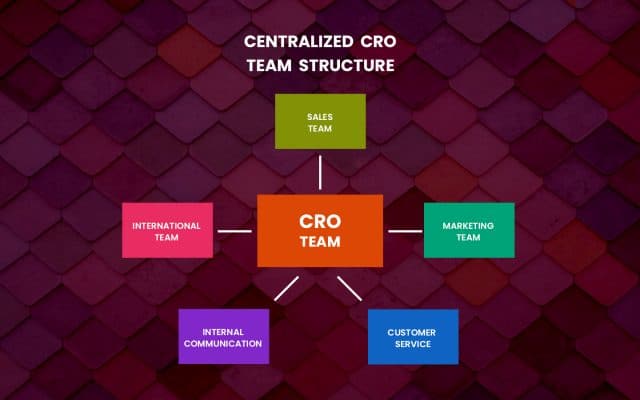
As you can see from the diagram above, a centralized CRO team model has all the knowledge concentrated in the same place. This means that this method allows the CRO team to be aware of the performance of the entire site and business, and it paves way for a strategic approach to optimization that includes the entire funnel.
Decentralized CRO team structure
Unlike the centralized model, optimization knowledge in the decentralized method is dispersed among different teams from several departments. This means that there are multiple teams responsible for optimization.
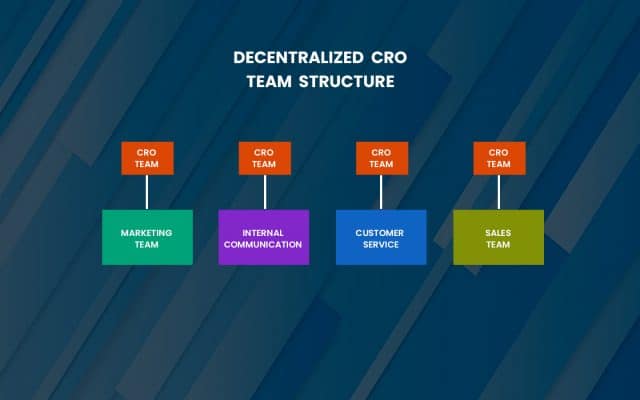
As shown in the diagram above, every department within an organization has people who are in charge of the optimization strategy. This approach is more common in SaaS companies – where teams want to move at their own pace, manage their own budgets separately, and operate outside of the marketing bubble.
Decentralized models are not a sure bet. If not carried out in a proper way, it can cause chaos by leading to inter-divisional rivalry. Each department might be tempted to build its own empire at the expense of others. Problems of coordination and control may also arise and once this happens, whatever is learned during the optimization process might not be shared with optimization teams from other departments.
Hybrid CRO team structure
This approach blends the decentralized and centralized CRO team models into one structure. The idea behind the hybrid model is to merge the strengths of each traditional approach, resulting in a solid conversion optimization strategy that drives the company.

As highlighted in the image above, the centralized team manages projects, analyzes, and shares results and learnings among all optimization teams from different departments. It’s also the responsibility of the centralized team to see to it that department projects are aligned, and there are no conflicts ensuing among different teams.
This approach can smoothly move the whole business forward if there are organized and ample resources (internal newsletters, sharing of learnings, meetings, etc.) in the organization.
The final point on the makeup of the CRO team: no matter the model you use in building and structuring a CRO team, make sure that there are no data silos (everyone should have access to pretty much every data in the company) and there always has to be sharing of knowledge to help spread the CRO culture.
3. The CRO Budget
Remember the adage, you need money to make money?
Well, that adage rings true in the world of conversion optimization.
An effective CRO program requires an investment of money. The good news is that conversion optimization is all about dollars and cents – this means that you’re bound to see its positive impact on your bottom line if the program is executed by experts.
We have a whole article on this blog that delves into details about the cost of hiring a CRO firm. So, in this section, I will only shine the spotlight on the main categories you must think of when budgeting for a CRO campaign.
Human Capital
Whether you hire an external CRO consultant or a firm, you need to pay them for the services rendered. The same applies to building an in-house team – but this usually costs more than outsourcing your CRO program to an agency.
An in-house CRO team would ideally need at least one expert each in the area of project management, strategy, UX design, data science, and a full stack developer. If you do the maths, you’d see that you will have to fork out nearly half a million dollars annually.
Duration of the project
Considering that conversion optimization is an ongoing process, you might not really see the real results if your CRO budget only covers two or three months. The minimum you should think about is six months. This is because it takes some considerable amounts of time to do conversion research, and you might need to run a couple of tests (and depending on the amount of your traffic, one test can take a few weeks to run) to get the desired outcome.
Cost of tools used on the project
Besides the human capital and duration of the project, you will also need to consider the cost of equipment needed to execute the project. This amount usually depends on the agency/consultant you engage and the features you require. The tools you will need typically include all of the above CRO tools: web analytics tools, user behavior analytics tools, and testing tools.
Costs of implementing the A/B tests
This is a common cost when working with an agency and you don’t have developers who can implement the A/B testing codes for you. However, this amount is not fixed. It usually depends on the number of A/B tests launched during the course of the program. Some CRO projects will need your CRO team to implement two or three tests on a monthly basis, while others may require the implementation of 8 to 10 tests.
Cost of hardcoding AB test winners on the site
When you launch an experiment and the winner that is not the default design on your site, you’d then need someone to write a production-ready code and to permanently deploy the winning variation on the site. This particular cost will only occur when you don’t have expert developers who can implement the winning variations. It’s also not a fixed cost, as it only applies when your CRO program generates an uplift better than the default design.
4. The Methodology
How you do conversion optimization matters. A successful CRO program requires a well-defined process. This is key. Without a well-defined process, a CRO program can lack direction.
Having a CRO methodology to follow, you’d know which issues to focus on first and which ones should you ignore. In other words, following a CRO process will serve you time and resources.
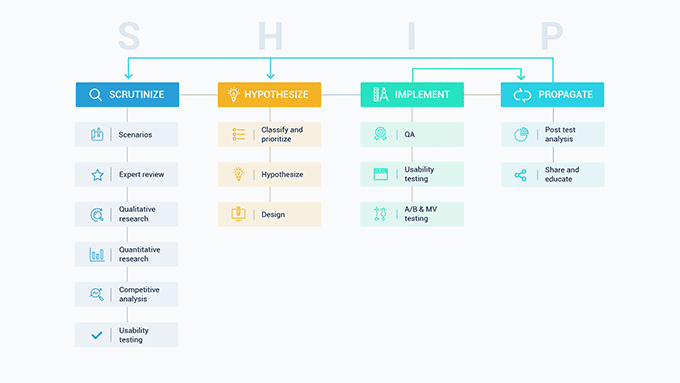
Here at Invesp, our CRO team follows a detailed SHIP optimization process and the Conversion framework to determine what areas of a website are not working and how to fix them. Our CRO team tends to spend much time dwelling on two stages: the scrutinize and the propagate stage.
Each and every stage of the process is very important, and it should be done thoroughly. However, sometimes you have to adjust accordingly, depending on factors such as the duration of the project.
According to Khalid:
“Yes, you need to follow a process. But at the same time, you need to know that there are always specifics to every site so you need to know when to follow the process, and when to divert from the process. Sometimes, there are instances where you need to adjust the process.”
One last thing you need to know about having a documented CRO process is that it gives you directions on how things are done; and then provides the focus for making things better, and how they are done determines how successful your program will be.
5. Setting the right expectations
Setting the right and transparent expectations before diving into the CRO project is an imperative thing to do. As a service-based company that offers website conversion optimization services, we have learned over the years that expectations are either the road to bliss or damnation.
Sometimes we are approached by clients who want us to increase their conversion rate by 500%. That’s a definition of a ridiculous and unrealistic expectation.
Since we are talking about transparency in this section, let me come out and say it: most of the case studies you see talking about 300%, 400%, or 500% increase in conversions are incomplete and inaccurate.
So, how do you deal with expectations?
As we start discussing a potential project, we educate clients about the fundamentals of CRO and help them understand the process we use. It’s important to know that not all tests you will launch will result in an uplift in conversions. Research studies show that only 1 out of 8 A/B tests have winning results.
Some good news, though. You can get some insights from these failed or inconclusive A/B tests – and they will help feed into the overall marketing plan that will eventually help you increase your conversions.
So there you have it. In the end, it all comes down to creating a genuine connection. How do you achieve that? Well, it all starts and ends with making sure that everyone involved in the program is on the same page before you delve into the project.
6. Good project management
Project management is that piece of the puzzle that many CEOs relegate to the backseat of a conversion program. But its importance in a CRO program can’t be overstated.
Better CRO project management = better CRO programs.
When project management is done right, it helps the CRO program run more smoothly. And it allows both teams involved in the project to focus on the issues that matter, free from the distractions that can happen during the project.
Good project management is even more essential when you have a high testing velocity of about three, four, or more tests per month.
Why?
Because when you conduct many tests, you are more likely going to spend time structuring the tests; doing QA on all variations making sure that there are no bugs to skew your data, and this might result in failure to track the insights that matter the most.
Conclusion
A successful CRO program takes a lot of commitment from all parties involved. There are no shortcuts to achieving the ultimate goals of your business through a proper CRO program. You should be ready to invest a lot of time, effort, patience, and money in this goal. When you pay close attention to the key components of a good CRO program, it will be easier for you to develop a logical, successful plan that will drive your entire business forward.


